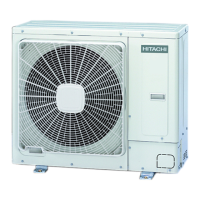What does compressor factor alarm mean in Hitachi Air Conditioner?
- CCynthia ChavezAug 30, 2025
A compressor factor alarm in your Hitachi Air Conditioner indicates that damage to the compressor has occurred 3 times within 6 hours.

What does compressor factor alarm mean in Hitachi Air Conditioner?
A compressor factor alarm in your Hitachi Air Conditioner indicates that damage to the compressor has occurred 3 times within 6 hours.
What does hydraulic alarm mean for Hitachi Air Conditioner?
A hydraulic alarm in your Hitachi Air Conditioner indicates that water pressure or water flow is not detected in the hydraulic cycle.
Why my Hitachi RAS-5HRNME-AF Air Conditioner shows undervoltage or overvoltage?
Undervoltage or overvoltage issues in your Hitachi Air Conditioner can stem from abnormalities in the outdoor PCB, inverter PCB, DM, or CB.
What causes unit over-temperature limit protection in my Hitachi RAS-5HRNME-AF Air Conditioner?
Unit over-temperature limit protection in your Hitachi Air Conditioner is activated if the water supply temperature is 5ºC more than the maximum water circuit temperature for 20 seconds.
What causes freeze protection by cold water inlet temperature detection in my Hitachi Air Conditioner?
Freeze protection by cold water inlet temperature detection in your Hitachi Air Conditioner is activated if the inlet water temperature is lower than 2 ºC.
What causes Opentherm communication failure in my Hitachi RAS-5HRNME-AF?
Opentherm communication failure in your Hitachi Air Conditioner is caused if there is no Opentherm communication for a continuous period of 1 minute.
What causes RF communication failure in my Hitachi Air Conditioner?
RF communication failure in your Hitachi Air Conditioner happens when there is no communication for 1 hour with one or two RF receivers which are bound to the RF-Bridge.
What causes unit capacity setting error in my Hitachi RAS-5HRNME-AF?
Unit capacity setting error in your Hitachi Air Conditioner is caused if there is no concordance between indoor outdoor unit capacity.
What causes LCD H-link transmission error in my Hitachi RAS-5HRNME-AF?
LCD H-link transmission error in your Hitachi Air Conditioner can be caused by no H-LINK communication for a continuous period of 1 minute between Indoor and LCD User control by connection wiring (breaking, wiring error, etc.).
What causes activation of high pressure switch in my Hitachi Air Conditioner?
Activation of the high pressure switch in your Hitachi Air Conditioner is caused when the high pressure (Pd) is higher than 3.0 MPa.
| Brand | Hitachi |
|---|---|
| Model | RAS-5HRNME-AF |
| Category | Air Conditioner |
| Language | English |
Essential guidelines for safe operation, installation, and product lifecycle management.
Details maximum system pressure and cut-out settings for safe operation.
Essential checks and warnings required before starting the system.
Manages compressor protection, defrosting, and airflow for optimal system performance.
Guides users on identifying and resolving common operational problems and abnormal sounds.
Provides a diagram and list of parts for the outdoor unit.
Illustrates the refrigerant flow and identifies key components in the cycle.
Important safety and installation guidelines for the outdoor unit.
Specifies clearance for single outdoor unit installations.
Specifies clearance for multiple outdoor unit installations.
Details space requirements for blocked outlet or lateral sides.
Specifies space for stacked and multi-row outdoor unit installations.
Guidelines for preparing a stable and suitable concrete foundation.
Instructions for mounting the unit and installing in windy conditions.
Methods for supporting refrigerant piping to prevent damage.
Procedures for connecting refrigerant piping to the outdoor unit.
Guidance on installing piping covers and handling stop valves.
Charts for designing refrigerant piping length based on height difference.
Specifies the correct pipe sizes for gas and liquid lines.
Safety guidelines and procedures for pipe brazing work.
Details the factory refrigerant charge amounts for different models.
Steps for collecting refrigerant into the outdoor unit during relocation.
Instructions for connecting the drain pipe using the boss.
General checks for electrical components, compliance, and power supply.
Diagrams for connecting electrical wiring to outdoor units.
Guide to setting DIP switches for various functions and configurations.
General guidelines for wiring, including noise protection and compliance.
Wiring diagrams and guidelines for connecting indoor and outdoor units.
Specifies minimum wire sizes for power and control connections.
Essential pre-run checks for the unit, electrical system, and refrigerant circuit.
Step-by-step guide for performing the test run using the indoor unit controls.
Instructions for initiating and managing test runs via outdoor unit DIP switches.
Details high pressure switch and fuse settings for compressor safety.
Explains how thermistor temperature affects fan motor output.
Lists alarm codes, their origins, details, and main causes.
Provides in-depth information on troubleshooting specific alarm codes and abnormalities.
Addresses issues related to pressure differences, gas temperature, and sensor failures.











